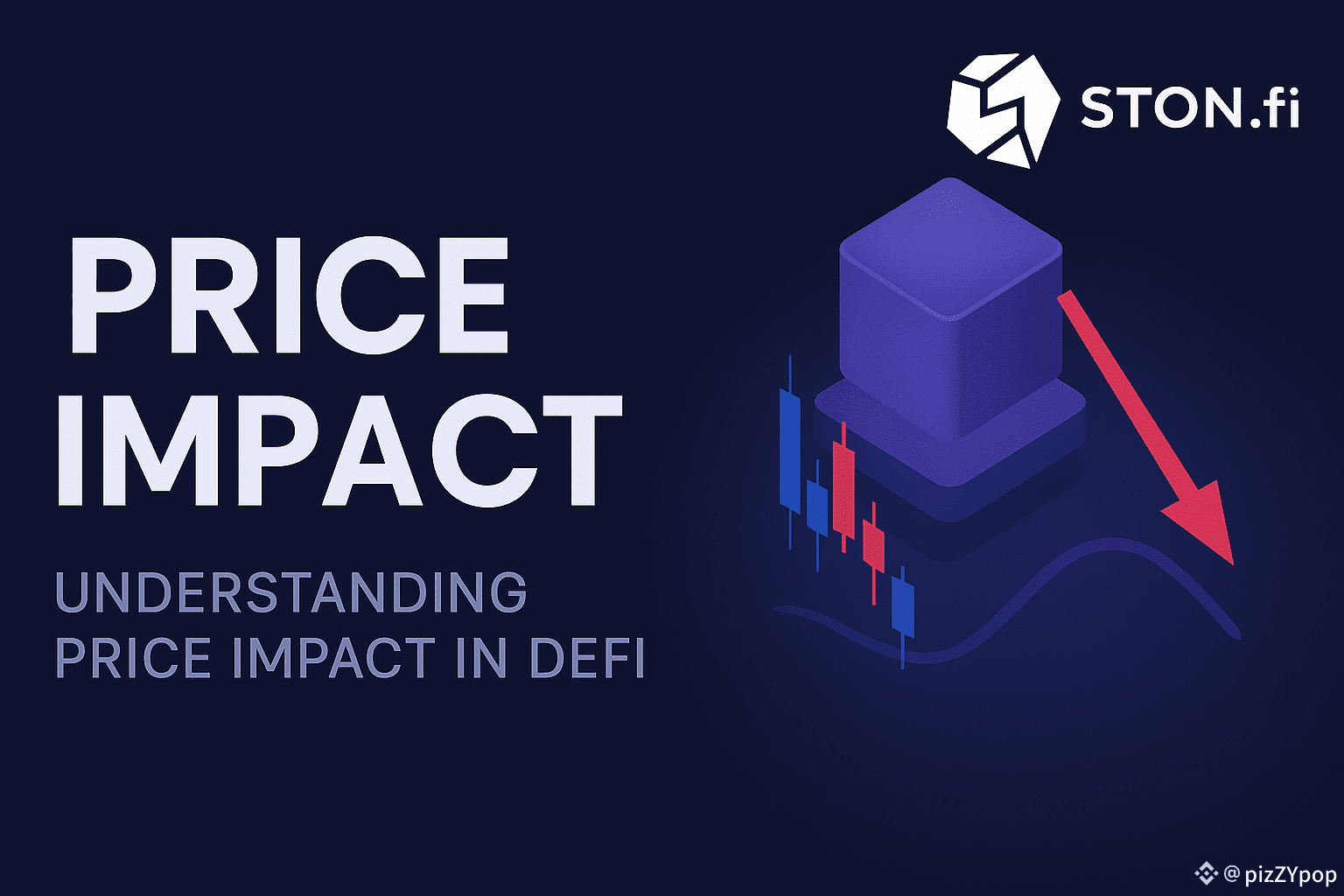
Every time you make a swap on a DEX like STON.fi, Uniswap, or PancakeSwap, something subtle but powerful happens behind the scenes – the price impact.
It’s not a bug. It’s not a fee.
It’s simply how markets balance themselves when you trade.
Yet, for many DeFi users, price impact remains an invisible factor, until it eats into their expected returns. Let’s break it down simply and see why it matters more than most people think.
What Exactly Is Price Impact?
In DeFi, price impact measures how much your trade moves the market price of the asset you’re swapping.
Think of a liquidity pool as a big bowl of tokens. When you pour one token in (say, $STON) and take another out (say, $USDT), the ratio in that bowl changes. The larger your swap compared to the pool size, the more you distort that ratio and the worse the rate you get.
So, price impact = the cost of moving the market.
Even if there’s no trading fee, the math of liquidity ensures that big trades move the price against you.
How Liquidity Pools Set Prices
Most decentralized exchanges use a Constant Product Market Maker (CPMM) formula:
x × y = k
Here:
• x = amount of Token A (say STON)
• y = amount of Token B (say USDT)
• k = constant value that must remain the same
When you swap tokens, the pool automatically adjusts both sides to keep that product constant.
Let’s say the pool starts with:
100,000 STON and 100,000 USDT
100,000 × 100,000 = 10,000,000,000
If you decide to swap 10,000 STON for USDT, the pool gives you some USDT but the STON side grows while the USDT side shrinks. The result? The exchange rate changes slightly against you.
That change – the difference between the original and new rate – is your price impact.
A Simple Example
Imagine a STON/USDT pool with deep liquidity:
• 500,000 STON
• 500,000 USDT
If you swap 1,000 STON, the pool barely notices.
But if you swap 100,000 STON, you’re eating a huge chunk of that pool, which pushes the STON price lower for you and for everyone else.
You’ll see the warning on DEX interfaces:
"Price Impact: -3.2%"
That means you’re effectively getting 3.2% less than the current market rate because your trade moved the pool balance.
Why It Deserves Attention
Price impact becomes a silent tax on big trades.
While trading fees (like 0.3%) are visible, price impact can easily surpass them, especially in smaller pools or during volatile moments.
Here’s what traders often miss:
• It’s not a fixed number – it depends on pool depth and trade size.
• It’s not slippage – though they feel similar, slippage is what happens after your trade due to price changes or front-running. Price impact is mathematical and happens instantly from your trade.
• It’s always there, even on-chain, even when gas is low.
So if you’re wondering why your large swaps yield less – this is it.
How To Minimize Price Impact
1. Split your trades.
Instead of swapping 10,000 STON at once, break it into smaller batches – say 5,000 + 5,000. Each one has less market effect.
2. Choose pools with more liquidity.
The deeper the pool, the smaller the price movement per trade. On STON.fi, for instance, swapping in high-volume pools like STON/TON or STON/USDt gives better efficiency.
3. Use aggregators or routers.
Tools like STON.fi’s swap router can automatically route your trade across multiple pools to get the best rate.
4. Keep an eye on slippage tolerance.
Set it too tight, and your transaction may fail; too loose, and you might lose value to volatility. Balance both price impact and slippage for safer swaps.
Why "Liquidity Depth" Is the Unsung Hero
Every liquidity provider contributes to reducing price impact.
When more tokens are added to the pool, its depth increases – meaning the same trade now moves the market less.
That’s why yield farming and LP rewards are not just incentives, they’re mechanisms that stabilize markets.
More liquidity = smaller impact = better rates for everyone.
So next time you provide liquidity, remember:
You’re not just earning yield – you’re keeping DeFi efficient.
The Reality of DeFi Markets
Price impact is what keeps DeFi fair.
It prevents someone with massive capital from instantly draining a pool or manipulating prices at will.
In traditional finance, market makers handle this with order books and human oversight.
In DeFi, it’s math – pure, automatic, and neutral.
That’s why DEXs like STON.fi thrive: they embrace this model transparently.
No gatekeepers, no hidden spreads. Just equations that balance the market in real time.
Looking Ahead
As DeFi evolves, new models (like concentrated liquidity and dynamic fees) are reducing price impact even further.
Protocols are experimenting with virtual liquidity and cross-DEX routing to make swaps smoother, especially for large transactions.
But the principle remains:
Every trade shifts the market and the system balances itself instantly.
Price impact reminds us that DeFi isn’t magic; it’s mathematics.
The more we understand it, the smarter we trade.
Key Reflections
Price impact isn’t just another DeFi term — it’s one of the most important forces shaping your every swap. Whether you’re trading 10 tokens or 10,000, understanding how liquidity depth, pool ratios, and order size interact can be the difference between a fair trade and a costly surprise.
In DeFi, your awareness is your edge. Knowing how price impact works doesn’t only help you minimize losses – it helps you trade smarter, contribute liquidity with confidence, and make sense of why certain swaps behave the way they do.
If you’re serious about mastering decentralized trading, it’s time to experience a platform that brings all of this into focus — with transparency, efficiency, and a seamless user flow built directly on the TON blockchain.
STON.fi isn’t just another DEX. It’s a decentralized, community-driven exchange that simplifies complex DeFi mechanics like price impact, routing, and slippage – so you can focus on what matters: making informed moves in real time.
Whether you’re:
• A new trader learning how swaps and liquidity pools work,
• A DeFi builder exploring the TON ecosystem, or
• A veteran investor who values security and full on-chain transparency —
STON.fi gives you a frictionless gateway to decentralized finance that works exactly as intended.
Now that you’ve understood price impact from the ground up, go experience it in motion.
Run a swap. Watch the numbers shift. See how optimal routing minimizes your impact and preserves your value.
And when you’re done — share your thoughts, insights, or questions with the community. You’ll find a ton of helpful users, builders, and moderators ready to help you grow your DeFi journey.
Start Trading Smarter
🔗 DEX: https://ston.fi/
💬 Telegram: https://t.me/stonfidex
Join the conversation, share your experience, and keep learning – because in DeFi, every swap teaches you something new.
